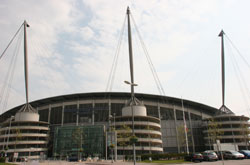
Pete Bradshaw, Social Responsibilty Manager, Manchester City Football Club
Manchester City Football Club is one of the greenest sporting stadiums in the world.
Before it was converted to a sporting complex, the land was home to dirty, heavy industry with a colliery, gas works, coal-fired power station and steel works - and was heavily contaminated with cyanide. In 2002, the site hosted the Commonwealth Games. Today, it's an exemplar of the green renaissance starting to run through the UK's sporting institutions.
Manchester City FC has already pioneered community involvement, transport and waste initiatives in Manchester. Now, they will power the SportCity complex with on-site renewable energy.
After assessing combined heat and power (CHP) and solar power, they found wind to be the most commercially viable option for the site. They then approached a number of companies, finally settling on Ecotricity for financial and ethical reasons, and because of the complexity of the arrangements for supply and the sale of any excess electricity.

The power will be generated on-site through an 85-metre tall, 2.6MW wind turbine. The turbine, which will reduce the club's carbon dioxide emissions by 3,500 tonnes per year, will be sited at the front of the stadium. As the turbine will generate more electricity than the stadium uses, the excess will flow into the local grid to be used by local homes or businesses.
The project will make Manchester City the greenest football club in the UK and could lead the way for other major clubs to follow suit.
For more information on the project, comtact:
Madeline Carroll of Ecotricity: 01453 769 318
Pete Bradshaw of Manchester City Football Club: 0161 438 7683


